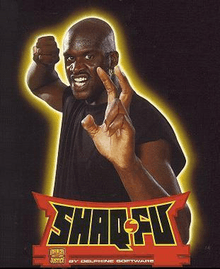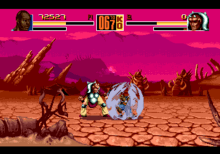Shaq Fu
Shaq Fu is a 2D fighting game released for the Sega Mega Drive / Genesis and Super Nintendo Entertainment System on October 28, 1994. It was ported to the Sega Game Gear, Nintendo Game Boy, and Commodore Amiga platforms in 1995. The game was published by Electronic Arts and developed by the now-defunct Delphine Software International. It features former professional basketball player Shaquille "Shaq" O'Neal as the player character. Shaq Fu was met with mixed responses from critics upon release, though it has since come to be considered one of the worst video games ever made.
| Shaq Fu | |
|---|---|
 Packaging for the Genesis version. | |
| Developer(s) |
|
| Publisher(s) |
|
| Designer(s) | Paul Cuisset |
| Composer(s) | Raphaël Gesqua |
| Platform(s) | Genesis, Super NES, Game Gear, Game Boy, Amiga |
| Release | |
| Genre(s) | Fighting |
| Mode(s) | Single-player, multi-player |
A sequel, Shaq Fu: A Legend Reborn, was announced in March 2014, and was released on June 5, 2018.[1]
Story
In the game's storyline, Shaquille O'Neal walks into a dojo while heading to a charity basketball game in Tokyo, Japan. After speaking with Leotsu, a martial arts master, Shaq goes to another dimension, the Second World, where he must rescue a young boy named Nezu from the evil mummy Sett Ra.
Development
While initially pitched as a basketball game, Shaq Fu became a fighting game after talks with Shaq, who is a self-proclaimed fan of Mortal Kombat; Delphine acknowledged that they could not compete directly with Street Fighter II from a technical perspective, instead building a game that highlighted the team's strengths at computer animations. The same rotoscoping techniques were used in their 1992 title Flashback: The Quest for Identity, where actors would be filmed against a Blue Screen, the frames would be digitized with the help of a Silicon Graphics SGI workstation, and artists would touch up the results using some of the roughly 7000 original character sketches as a base for defining characters. Shaq portrays himself in the game, though many sequences were directed by a Kung Fu expert; other characters were filmed by movie stuntmen and women, and O'Neal also assisted with some of the dialogue. Roughly 40 people worked on the project in total.
To promote the game's launch, Shaq released his second studio rap album, Shaq Fu: Da Return, which peaked at #67 in the US' Billboard 200 chart and #19 in Billboard's Top R&B/Hip-Hop Albums chart; those who pre-ordered or purchased the console versions of the game in its initial launch also had gotten a Promotional CD featuring the track "Stand and Deliver".
Variations

The Genesis version of Shaq Fu has five more playable characters (Auroch, Colonel, Diesel, Leotsu, and Nezu) and three more stages (The Lab, The Wasteland, and Yasko Mines) than the Super NES version, thus the Genesis version has a longer story mode. The North Gate/South Gate stage is accessible in the SNES version with a cheat code, whereas the Genesis version has the North Gate/South Gate stage available by default. The Amiga version contains the same content as the Genesis version (it keeps the text "Licensed by Sega Enterprises, LTD" left over from that version on the title screen), though the backgrounds have no animation. It also only has three tunes; there is no background music during the fights.
The Game Boy version has the same seven characters as the Super NES version, whereas the Game Gear version only has six characters (Shaq, Leotsu, Mephis, Rajah, Kaori, and Sett Ra). Both the Game Boy and Game Gear versions lack a tournament mode and in-game voices.
Both the Genesis and SNES versions of the game contained a hidden button sequence that would initiate a "blood code" in the spirit of Mortal Kombat. The blood effects were subdued and minor which kept the game at its "MA-13" (known by modern rating standard as "T") rating. However, the blood code gave access to finishing moves within the game that were triggered by striking the opponent in a certain way to end the match. The finishing moves were not gory as those depicted in the fatalities of Mortal Kombat, but were considerably more violent when performed against monster-type characters in the game, rather than humans. Some of the finishing moves that have been discovered include the following examples:
- Sett Ra, when struck with a high attack toward his head, would drop to his knees as his head caught fire. The body of Sett Ra would then dissolve, the wraps falling to the ground and the smoldering shoulder armor tumbling forward.
- Beast, when struck in a certain way, would have his skin dissolve away revealing a skeleton which crumbles to the ground.
- Mephis, when struck with a mid-range attack, would shatter into ghost-like shards which fade away into the air, leaving his decrepit robe behind.
- Voodoo, when struck in a certain way, would fade into smoke, leaving her clothing behind on the ground.
- Genesis-exclusive character Auroch would turn to stone and explode if struck with a mid-range attack.
Reception
Shaq Fu received mixed reviews at the time of its release. GamePro gave the SNES version a positive review, saying that the unusually small size of the sprites is balanced off by the incredibly fast game speed. They also praised the "ultra sharp" controls and impressive digitized graphics.[2] They reviewed the Genesis version as superior to the SNES version due to its additional characters and improved controls, and concluded that the game is "fun once you get used to the small, fast sprites."[3] One of the multiple reviewers at Electronic Gaming Monthly scored it as a 6/10, and another gave it a 4/10.[4] It received a grade of D from Entertainment Weekly.[5] GamesMaster gave the Genesis and SNES versions 81% and 83% respectively.[6] Mean Machines Sega Magazine gave the Genesis version 79%.[7]
In contrast to their reactions to the SNES and Genesis versions, GamePro panned the Game Boy release, saying it dumbs down the gameplay, loses so much graphical detail that the characters are unrecognizable, and makes the music far too pervasive.[8]
Next Generation reviewed the Genesis version of the game, rating it two stars out of five, and stated that "Shaq Fu includes everything a good fighting game needs, with the exception of good fighting."[9]
Retrospective criticism of the game has been generally negative. GameTrailers rated it number 4 Worst in their "Top Ten Best and Worst Video Games".[10] In response to the negative feedback to the game, Levi Buchanan from IGN stated it was undeserved as a result of collective exaggerations.[11] In the September 1997, Nintendo Power had 12 staff members vote in a list for the top 100 games of all time.[12] This list also included a 10 worst games of all-time list voted by the staff, which placed Shaq Fu at 3rd worst place on their list.[13] The article stated that it was "not possible to come up with a worse idea than this."[13] The same year, Electronic Gaming Monthly ranked it number 10 on their "Top 10 Worst Games of All Time".[14]
Sequel
In 1995, there were plans for Delphine Software to develop a sequel for the series, titled Shaq Fu 2, intended to be released for the Sega Genesis/Mega Drive and Super Nintendo sometime during the fourth quarter of 1995 or early 1996. The project was ultimately cancelled due to the mixed reception of the first entry, though in the years to follow, original concept art for five new characters (along with seven returning characters, those being Shaq, Rajah, Voodoo, Leotsu, Mephis, Kaori, and Sett Ra) and early stage designs that would have been a part of the game have surfaced online through the portfolio of one of the developers.
A sequel, titled Shaq Fu: A Legend Reborn, was released in June 2018.
See also
References
- "Shaq Fu: A Legend Reborn launches June 5". Gematsu.com. Retrieved December 13, 2018.
- "ProReview: Shaq Fu". GamePro (64). IDG. November 1994. p. 124.
- "ProReview: Shaq Fu". GamePro (65). IDG. December 1994. p. 98.
- Lachel, Cyril (17 August 2013). "Shaq Fu: What Did Critics Think at the Time?". Defunct Games. Retrieved 17 February 2014.
- Strauss, Bob (16 December 1994). "Shaq-Fu". Weekly Inc. Retrieved 17 February 2014.
- "Games_Master_Issue_023__1994_11__Future_Publishing__GB__300dpi_". Archive.org. Retrieved 7 January 2019 – via Internet Archive.
- "Mean Machines Sega Magazine Issue 24". 1 October 1994. Retrieved 7 January 2019 – via Internet Archive.
- "ProReview: Shaq Fu". GamePro. No. 88. IDG. January 1996. p. 110.
- "Finals". Next Generation. No. 1. Imagine Media. January 1995. p. 101.
- Top Ten Best and Worst Games of All Time, GameTrailers.com.
- Buchanan, Levi (October 20, 2008). "In Defense of Shaq Fu". IGN. Retrieved October 8, 2011.
- "100 Best Games of All Time". Nintendo Power. Vol. 100. September 1997. p. 88.
- "100 Best Games of All Time". Nintendo Power. Vol. 100. September 1997. p. 97.
- "The Top 10 Worst Games of All Time". Electronic Gaming Monthly. No. 100. Ziff Davis. November 1997. p. 107. Note: Contrary to the title, the intro to the article explicitly states that the list covers console video games only, meaning PC games and arcade games were not eligible.
External links
- Shaq Fu at MobyGames
- The Sega Genesis version of Shaq Fu can be played for free in the browser at the Internet Archive